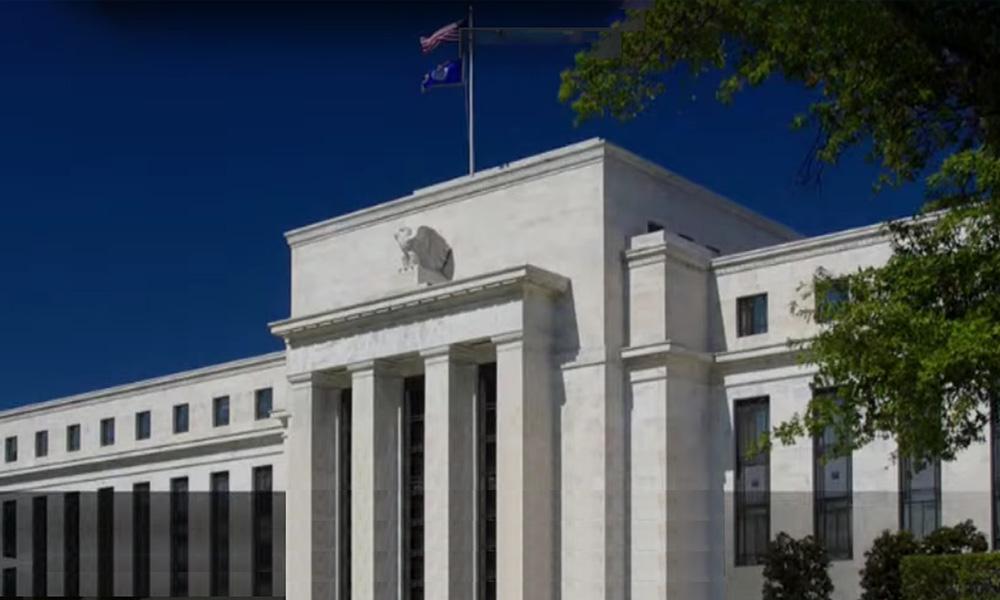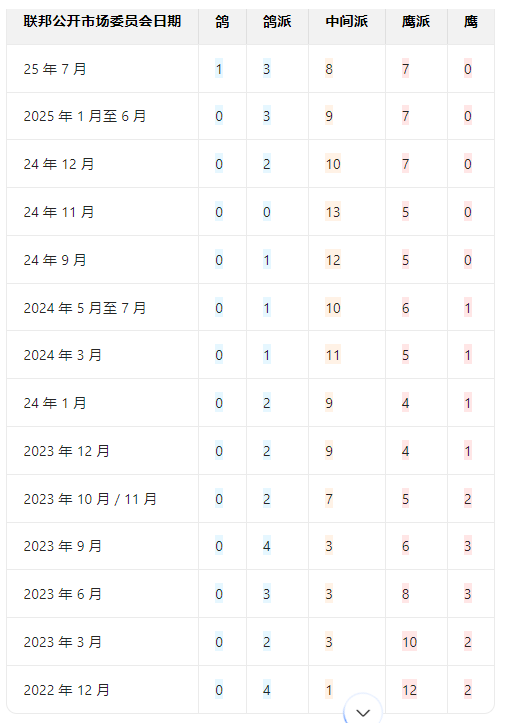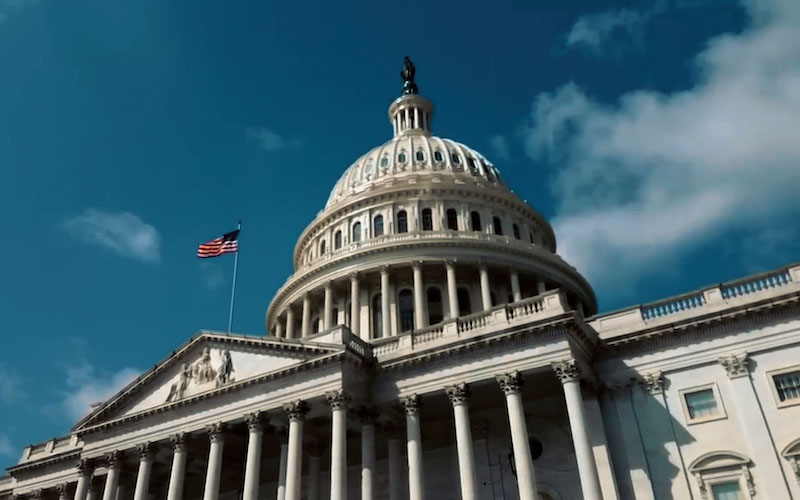A review of recent hawkish and dovish comments from Fed officials
2025-07-22 23:46:58

Before the Federal Reserve's July 29-30 policy meeting, the Trump administration increased pressure: on the one hand, White House officials reviewed the compliance of the Fed's $2.5 billion headquarters renovation project, and Treasury Secretary Scott Bessant called for a detailed investigation of the Fed's non-monetary operations, indirectly expressing his dissatisfaction with Powell; on the other hand, Trump himself repeatedly publicly accused Powell of not pushing for a timely interest rate cut, and explicitly called for his resignation or criticized him at least six times since 2025. These criticisms were concentrated in April (1 time), May (1 time) and July (at least 4 times, including public remarks on July 2, 13 and 16).
Although Trump has mentioned firing Powell, he also said that such a move is "extremely unlikely" to be implemented. In response to the government's pressure, the outside world has voiced to defend the independence of the Federal Reserve. Former Federal Reserve Chair Janet Yellen bluntly stated on July 22 that Trump's pressure on the Federal Reserve to cut interest rates could lead to "very bad" economic consequences, such as a rebound in inflation and increased borrowing costs. She stressed that the Federal Reserve must maintain its independence and pointed out that the Fed's previous success in keeping inflation close to the 2% target was enough to prove that it did not need external intervention. It is worth noting that Yellen had previously criticized Trump's tariff policy in April, believing that the policy had damaged the US economy and the international community's trust in the United States.
At the same time, Mohamed El-Erian, a well-known economist, Bloomberg columnist, and dean of Queens College, Cambridge University, called on Powell to resign on his own initiative through the X platform on July 22, becoming the first well-known economist to publicly advocate Powell's resignation. He believes that in the face of continued pressure from Trump and his allies, Powell's stay in office may pose a greater threat to the independence of the Federal Reserve, and this view immediately sparked widespread controversy.
Inside the Fed: Policy stance diverges
Ahead of the July policy meeting, the opinions of the 19 Fed policymakers were clearly divided:
Doves (2-3 people): They are more concerned about labor market risks and support an early rate cut. For example, Board member Christopher Waller explicitly advocates a 25 basis point rate cut in July.
Hawks (2-4): Focus on the threat of inflation and advocate maintaining current interest rates. For example, Board member Adrienne Kugler emphasized the need to be vigilant about the potential lasting impact of tariffs on prices.
Centrists (7-9): Agree with Powell's position, prefer to wait for summer economic data before making decisions, and temporarily maintain the policy interest rate range of 4.25%-4.50%.
While several Fed policymakers have made the case for lower borrowing costs at upcoming meetings, the current views of the central bank’s 19 policymakers are mostly in line with Powell, who has said he wants to wait for data through the summer to judge whether it is necessary to lower the policy rate to its current range of 4.25% to 4.50%.
Here are some comments from Fed officials since their last policy meeting, which we categorize as "dovish," "centrist," and "hawkish" to simplify their monetary policy biases. Doves are more concerned about labor market risks and may want to cut rates more quickly, while hawks are more concerned about inflation threats and may be more cautious about cutting rates.
Dove
Christopher Waller, Fed Governor, Permanent Voter: "It would be reasonable to cut the FOMC policy rate by 25 basis points in two weeks." July 17, 2025
Michelle Baumann, Vice President for Supervision and Permanent Voter: "Now is the time to consider adjusting the policy rate." June 23, 2025
Lisa Cook, Chair, permanent elector: No longer comment publicly on monetary policy from June 3, 2025.
Chicago Fed President and 2025 voter Austan Goolsbee: "Overall, I continue to believe that current levels could lead to a significant reduction in interest rates over the next year or so." July 18, 2025
Centrists
Jerome Powell, Fed Chair and Permanent Voter: "As long as the U.S. economy is in good shape, we think the prudent thing to do is to wait, learn more, and see what those effects might be." July 1, 2025
John Williams, president of the New York Fed and permanent voter: "It is important to note that the impact of tariffs is still in its early stages and will take some time to fully play out." July 16, 2025
Philip Jefferson, Vice Chairman, Permanent Voter: No public comments on monetary policy since May 14, 2025.
Michael Barr, Chairman, Permanent Elector: "Monetary policy is well positioned to allow us to wait and see how the economic situation develops." June 26, 2025
Adrienne Kugler, President, Permanent Elector: "I believe it would be appropriate to maintain our policy rate at its current level for some time." July 17, 2025.
Boston Fed President Susan Collins, a 2025 voter: "At this point, an 'aggressive and patient' approach to monetary policy remains appropriate."
Anna Paulson, President of the Philadelphia Fed, 2026 voter: Has not made any public comments on monetary policy since taking office on July 1, 2025.
Mary Daly, San Francisco Fed President and 2027 Voter: "I don't want to see any further weakness in the labor market... I really don't want to see that, and that's why you can't wait forever for rate cuts." July 17, 2025
Hawk
Kansas City Fed President and 2025 elector Jeffrey Schmid: "The current monetary policy stance, 'wait and see,' is appropriate." June 24, 2025
Alberto Musalem, president of the Federal Reserve Bank of St. Louis and a 2025 voter: "Tariffs could have a temporary effect on prices... or they could have a more permanent effect... I might be able to form a rough idea by October, November or December." July 10, 2025
Neel Kashkari, president of the Minneapolis Fed and a 2026 voter: "If we cut rates in September and the impact of tariffs is felt this fall, I don't think we should default to easing policy." June 27, 2025
Cleveland Fed President and 2026 voter Beth Hammack: "I don't think there's a need to actually lower (rates) unless we see some material weakness in the labor market." July 14, 2025
Dallas Fed President Lori Logan, 2026 voter: "My base case is that we're going to need to keep interest rates moderately restrained for some time." July 15, 2025
Thomas Barkin, president of the Richmond Fed and a 2027 voter: "Given the current strength of the economy, we have time to patiently track developments and allow visibility to improve." June 26, 2025
Note: The current policy rate target range is 4.25%-4.50%. The median forecast of Fed policymakers in June was a 0.5 percentage point rate cut this year, but 7 of the 19 policymakers predicted no rate cut.

(Statistics of various policy makers before recent Fed meetings)
The Fed's seven governors, including the Fed chair and vice chair, are nominated by the president and confirmed by the Senate. Three of them, Waller, Bowman and Powell, were nominated by Trump; the remaining four were nominated by former President Joe Biden. Each of them votes at the eight annual meetings of the Federal Open Market Committee (FOMC).
All 12 regional Fed presidents discuss and debate monetary policy at meetings, but only five have voting rights, including the New York Fed president and four others, who rotate votes for one-year terms. The Fed regional bank presidents are selected by the directors of their respective regional banks and must be approved by the Fed's Board of Governors.
- Risk Warning and Disclaimer
- The market involves risk, and trading may not be suitable for all investors. This article is for reference only and does not constitute personal investment advice, nor does it take into account certain users’ specific investment objectives, financial situation, or other needs. Any investment decisions made based on this information are at your own risk.





















